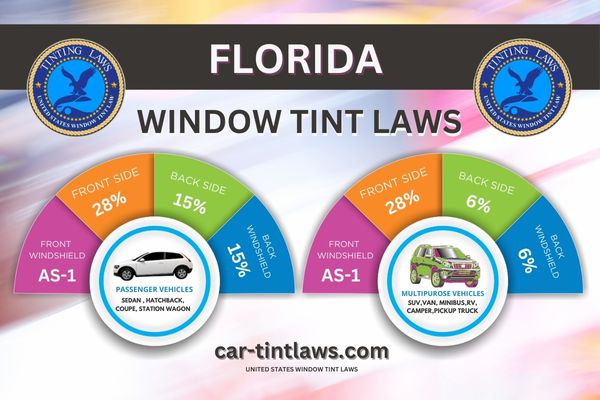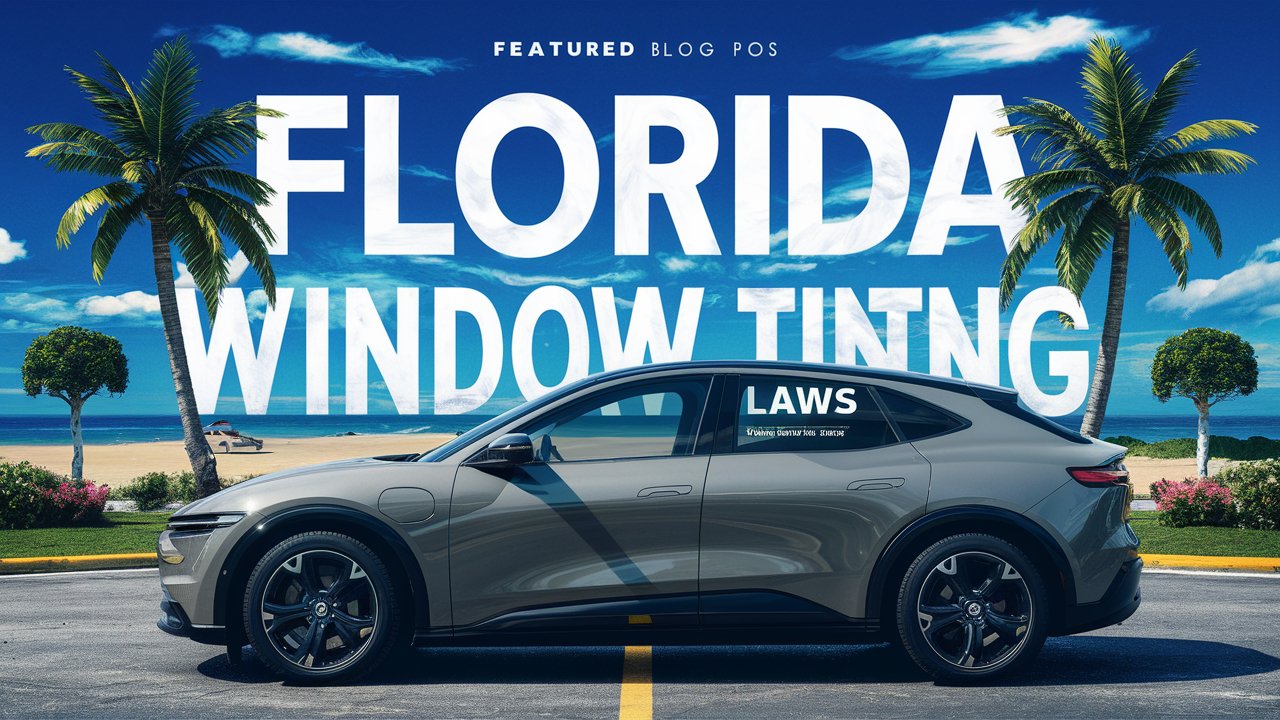Imagine you’ve just moved to Florida and you notice that many vehicles have tinted windows.
It’s not just about aesthetics; Florida has specific laws regarding window tinting that you need to follow.
For instance, sedans must allow more than 28% of light in through the front side windows, while SUVs have a different standard.
But it’s not just about how dark the tint can be; there are also rules on how reflective it can be, and even the need for compliance stickers.
Curious about the implications and how to stay within the law?
Window Tint Darkness in Florida
When it comes to tint darkness in Florida, you’ll need to be aware of the specific regulations for different types of vehicles.
For sedans, the front side windows must allow at least 28% of light through, while the back side and rear windows need to permit more than 15% visible light transmission (VLT).
SUVs and vans follow the same rules for the front side windows, but their back side and rear windows can also maintain the 15% VLT, ensuring compliance with state law.
Tint darkness for sedans:
- Windshield: Non-reflective tint is allowed on the top 6 inches of the windshield.
- Front Side windows: Must allow at least 28% of light in.
- Back Side windows: Must allow more than 15% of light in.
- Rear Window: Must allow more than 15% of light in.
Tint darkness for SUV and Vans:
- Windshield: Non-reflective tint is allowed on the top 6 inches of the windshield.
- Front Side windows: Must allow more than 28% of light in.
- Back Side windows: Must allow more than 6% of light in.
- Rear window: Must allow more than 6% of light in.
- Reflective tint: Reflective tint on rear windows must not exceed 35% reflection.
Window Tint Reflection in Florida
When considering window tint reflection in Florida, you’ll need to be aware of the specific limits set for different types of vehicles.
For sedans, the maximum reflection allowed is 25% for front side windows and 35% for rear windows.
SUVs and vans have slightly different standards, and it’s important to confirm your vehicle adheres to these regulations to maintain legal compliance and best tint performance.
Tint reflection for sedans:
- Front Side windows: Must not exceed 25% reflection.
- Back Side windows: Must not exceed 25% reflection.
Tint reflection for SUV and vans:
- Rear windows on SUVs and vans: Must not exceed 35% reflectivity.
Reflective tints are beneficial for reducing glare and heat buildup in your vehicle, especially in Florida’s hot climate.
It’s crucial to ensure that the tint film used complies with Florida’s regulations to avoid legal consequences.
Adhering to the state’s reflectivity limits not only enhances your vehicle’s appearance and comfort but also promotes safer driving conditions for everyone on the road.
Other Florida window tint rules and regulations
- Side Mirrors: No restrictions.
- Restricted Colors: In Florida, all tint colors are permitted.
- Certificates: Manufacturers of film need to certify the film they sell in the state. Ensure your dealer is using certified film.
- Stickers: The sticker/label of compliance to identify legal tinting is required between the film & glass on each tinted window.
- Medical Exceptions: Florida allows medical exemptions for special tint. For specific terms of the exemption, refer to Florida state law.
- Penalties: Failure to comply can result in fines. Penalties vary depending on the severity of the violation.

Medical Exemptions for Window Tint Rules in Florida
Individuals with specific medical conditions, like Lupus or UV sensitivity, can obtain exemptions that permit darker window tints than standard Florida regulations.
These medical exemptions are designed to offer additional protection for those with particular conditions that make them more sensitive to sunlight.
To qualify for a medical exemption, you’ll need to provide medical documentation that verifies your condition.
This typically involves obtaining a letter from a licensed physician that outlines your need for darker window tints.
Once you have the necessary documentation, you’ll need to follow the state’s application process.
This process usually includes submitting the medical paperwork along with an application form to the appropriate Florida state department.
Once approved, it’s essential to carry the necessary paperwork in your vehicle at all times.
This documentation serves as proof of compliance with Florida’s tinting laws.
Without this paperwork, you could still be subject to penalties despite having a valid exemption.
By adhering to these guidelines, you can make sure that your vehicle remains compliant while also protecting your health.
The medical exemption process is straightforward but requires careful attention to detail to make certain that all requirements are met.
Florida Window Tint Ticket Cost
Getting a ticket for illegal window tint in Florida can set you back anywhere from $114 to $164, depending on the county.
When you’re driving around with tint that doesn’t comply with Florida window tinting laws, you run the risk of getting fined.
These fines aren’t just a financial burden; they can also impact your driving record and might even lead to higher insurance rates.
If you receive a fix-it ticket for your window tint, you’ll be required to remove or adjust the tint to meet state regulations.
This means additional costs for tint removal or replacement, on top of the initial fine.
Florida enforces these laws to guarantee road safety and visibility for law enforcement officers.
It’s essential for drivers to understand these regulations to avoid any potential legal issues and penalties.
Florida Climate and Sunlight Data
Florida’s climate is characterized by year-round sunshine, with the state receiving between 230 and 260 days of sun annually.
This, combined with intense UV radiation due to its proximity to the equator, makes window tinting essential for protecting against harmful rays.
Additionally, the heat and humidity prevalent in Florida necessitate effective window tinting solutions to reduce heat gain and improve energy efficiency in homes and vehicles.
Intense UV Radiation
Given its average of 237 sunny days per year, Florida exposes you to intense UV radiation that can heavily impact your health.
As a resident of the Sunshine State, you’re frequently subjected to high UV index levels, especially during the summer.
This increased UV exposure is due to Florida’s proximity to the equator, which results in more direct sunlight.
Prolonged exposure to this intense UV radiation can lead to significant skin damage, including sunburn and an elevated risk of skin cancer.
To help protect against these harmful effects, window tinting can be an effective solution.
By reducing the penetration of UV rays into your home or vehicle, tinting creates a safer environment, shielding you from the adverse impacts of prolonged UV exposure.
Understanding that while window tinting laws in Florida aim to balance safety and visibility, they also provide an important layer of protection against the Sunshine State’s harsh sunlight.
Year-Round Sunshine
With an average of 237 sunny days annually, Florida’s abundant sunlight underscores the need for effective window tinting.
The Sunshine State’s proximity to the equator means you’re consistently exposed to high levels of UV radiation.
This constant exposure can notably impact your vehicle’s and home’s interiors, leading to potential fading and heat buildup.
Installing window tint in Florida isn’t just a luxury; it’s a necessity.
The tint helps shield against harmful UV rays, enhancing comfort within your living and driving spaces.
You’ll find that window tinting also boosts energy efficiency by reducing the amount of heat entering through the windows, which can lower cooling costs.
Belonging to a community that values protection and efficiency is important, and window tinting in Florida is a smart step in that direction.
Whether you’re a long-time resident or new to the state, understanding the benefits of window tinting can help you make informed decisions.
As you navigate the sunny days, remember that window tinting offers a practical solution to maintain your comfort and protect your investments year-round.
Heat and Humidity
In a state where you experience high heat and humidity year-round, window tinting becomes essential for keeping your interiors cool and comfortable.
Florida’s subtropical climate means you deal with intense sunlight exposure that leads to significant heat gain inside vehicles and homes.
This makes tinting a critical solution to reduce temperatures and protect against the harsh sun.
With an average of 237 days of sunshine annually, the demand for effective heat and UV protection through window tinting in Florida is evident.
The state’s constant high heat and humidity levels make it essential to manage interior temperatures efficiently.
Tinting windows helps lower energy costs by reducing the need for excessive air conditioning usage, which is crucial in such a hot climate.
Moreover, Florida’s strong sunlight can cause significant discomfort and potential health risks without proper window tinting.
By complying with state tinting laws, you ensure both safety and comfort for yourself and your family.
The combination of Florida’s hot climate and powerful sunlight underscores the importance of understanding and adhering to local tinting regulations, ensuring your interiors remain cool and inviting throughout the year.
References
Florida 2016 Statutes sections 316.2951 through 316.2956: (see sections 316.2951 to 316.2956)
Florida Medical Exemption Application Form (.pdf file)
Frequently Asked Questions
What Is the Darkest Legal Tint in Florida?
The darkest legal tint’s 28% VLT for front windows. Benefits include heat reduction and privacy, but drawbacks like visibility issues exist.
Alternatives like ceramic tints offer better UV protection without breaking the law. Stay informed and connected!
Can I Have 20% Tint in Florida?
You can’t have 20% tint on your front side windows because it’s below the legal limit.
The tint percentage must meet 28% due to film transparency and visibility concerns. Legal consequences for tint violations include fines and penalties.
Can You Get Pulled Over for 5% Tint in Florida?
Imagine you’re driving with 5% tint—law enforcement might pull you over due to tint visibility and safety concerns. The consequences?
Citations or fines. Consider legal modifications or alternatives to avoid these enforcement headaches and stay compliant.
What Is the Tint Law in Florida 2024?
In 2024, Florida’s tint law states front windows need 28% light transmission, back windows 15%.
Tint violations can lead to fines. Some medical exemptions exist. Enforcement focuses on tint percentage compliance, ensuring safety on the roads.
Conclusion
Florida’s window tinting laws are clearly a bureaucratic masterpiece, aren’t they?
Ensure your sedan or SUV adheres to the specific light and reflection limits, slap on those compliance stickers, and keep your medical exemptions well-documented.
Failure to adhere means fines, because who wouldn’t want to pay for that oversight?
In the end, understanding these regulations guarantees your vehicle stays within legal limits, maintaining both safety and visibility on Florida’s sun-drenched roads.
